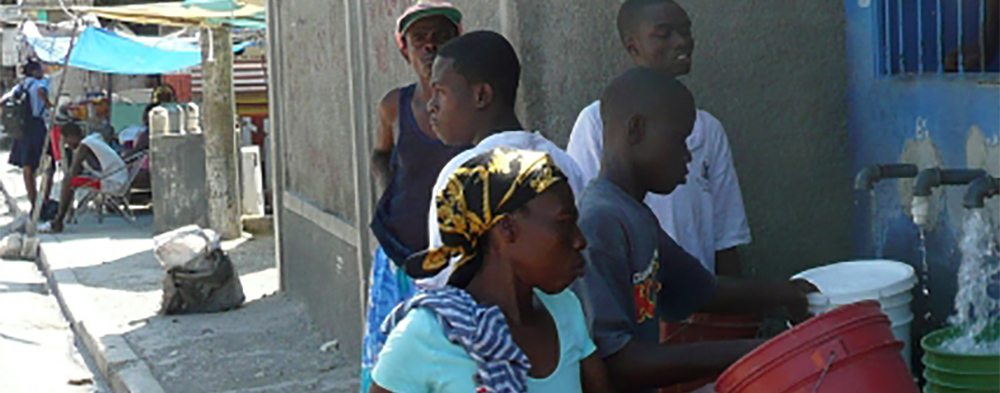Several days ago, Pierre Jacquemot, chairperson of GRET, was invited by the Agence française de développement (AFD) to participate in the ID4D conference on the subject of “Water: what challenges and what solutions for future cities?”. Following this event for World Water Day, GRET takes a look at approaches and solutions identified to improve access of the most vulnerable urban populations to improved sustainable water, sanitation and rainwater management services.
At the end of 2015, despite the good news that the Millennium Development Goal (MDG) on drinking water*, had been reached, we learnt that the proportion of urban populations benefitting from a connected drinking water supply service was 79 %. In twenty years, this figure has not progressed**. As for sanitation, one urban dweller out of five does not have an improved system. These quantitative global issues are compounded by poverty: access to water and sanitation remains one of the most significant poverty markers in African and Asian cities. This is also the case in Haitian cities, where the poorest 20 % of the urban population has six times less chances of benefiting from an improved sanitation service than the wealthiest 20 %.
In addition to access to these services, there is the issue of their quality and their effectiveness: today, the inhabitants of Nairobi, Saint-Louis du Sénégal, Yangon and Lima are no longer satisfied with an intermittent, mediocre service and are demanding a high level of responsiveness in the event of breakdowns. They want to pay their bills easily, on internet for example. Urban lifestyles are often conducive to higher water consumption, whereas resources are under pressure.
Lastly, cities are often located in zones that are vulnerable to the water impacts expected from climate change (coastal areas, river banks, flood plains, etc.). Their essential services will have to deal with this new situation – in particular with drought and flooding – while uncertainty relating to these events remains strong, which does not facilitate adaptation or decision-making.
There is of course also a financial issue: apart from funding of supply extensions and of operation of services, the need to renew infrastructures that were built thirty or forty years ago is evident, but funding of these upgrades to the service has not necessarily been anticipated.
These current challenges, combined with rapid, poorly planned urbanisation, demonstrate the extent to which universal access to improved services, targeted by the Sustainable Development Goals (SDGs), is necessary and ambitious.
Solutions for the most vulnerable urban populations
In Africa, South-East Asia, the Caribbean and the Indian Ocean, GRET works alongside project owners in charge of supplying essential services to improve and guarantee the inclusion of the most vulnerable neighbourhoods in the solutions proposed.
Made-to-measure responses, based on co-constructed diagnoses
Cities are complex and the diagnostic period is crucial: GRET therefore promotes the importance of prior diagnoses and does not recommend using ready-made solutions defined elsewhere. Inhabitants and project owners know their territories best: they are therefore the best source of solutions, with support from experts who are receptive to their knowledge.
In Mandalay, a city with one million inhabitants located in the centre of Myanmar, GRET works in partnership with Suez Consulting, alongside the municipality, to supply 2,000 households with drinking water and strengthen the capacities of the municipality to manage the service. The field diagnosis phase lasted one year and has just been completed: it gave rise to a significant social marketing social strategy, the implementation of which is just beginning.
Alternative solutions suited to precarious neighbourhoods
Peripheral or precarious neighbourhoods are often neglected by formal service offerings, and alternative solutions are often varied and generally more costly (water distributors, dependent or independent mini-networks, mini-sewers, pit-emptying services, etc.). GRET therefore seeks to experiment ad hoc solutions that make it possible to rationalise this alternative service offer and to regulate it without taking from its flexibility or its scalability.
In Laos, work conducted on standards made it possible to decrease the costs of infrastructures and connections. In Port-au-Prince, in Haiti, management by inhabitants in some poorer neighbourhoods makes it possible to get around the administrative difficulties that a public operator might encounter to supply the service. In Antananarivo, in Madagascar, the pit-emptying service was strengthened and treatment solutions were decentralised to make the sanitation network less costly… In Saint-Louis du Sénégal, social marketing appropriate for the populations of some neighbourhoods promotes a collective sanitation service.
Enabling solidarity to emerge to fund services
Financial requirements for operation and extension of services are substantial. Income from billing alone does not cover all costs: this can lead project owners to apply prices that are far higher than what households can afford. It is therefore necessary to manage operating and investment costs as best possible, but above all to generate solidarity via price grids and grants: transfers between types of users, between wealthy and poor, between cities and rural areas, between sectors, etc.
Organising stakeholder coalitions
GRET also seeks innovative solutions at institutional level: apart from its traditional, crucial activities strengthening project owners and private operators, GRET is now supporting civil society in Senegal, with support from the world of research, to foster and strengthen the role of citizen regulation of sectoral policies.
* [1] The MDG worldwide target for drinking water – ensure access to improved water points for 88 % of the population by 2015 – was reached and exceeded in 2010. Source: “Progress on Sanitation and Drinking Water, 2015 update and MDG assessment” published by the World Health Organisation (WHO).
** According to the WHO/Unicef Joint Monitoring Report on water and sanitation (JMP).



